 In trying to convince myself to get back into beekeeping, I had just finished having a long conversation with a friend regarding honey and explaining that we now import most of our honey from China. **
In trying to convince myself to get back into beekeeping, I had just finished having a long conversation with a friend regarding honey and explaining that we now import most of our honey from China. **Need I say, you never know what is in that, same with some Orange honey – stick to native plants, wildflower honey – local is best for a lot of reasons – on and on.
He responded that we also get some from South America “The honey from Columbia … do you suppose it has marijuana and poppy pollen in it?
I understand those are the two biggest agricultural crops in Columbia.”
Had to burst his bubble. NO. Cannabis has no nectar, the main ingredient of honey and I do not think it is insect pollinated. Wind does the trick.
Poppies are visited by bees but it is for pollen. You will find them busy on California Poppies but it is for pollen not nectar. This is not to say that bees do not get drunk sometimes, they do, but those who imbibe fermented nectar suffer the same fate (and worse) than humans – they have many more flying accidents than sober ones and can sometimes forget how to get back to their hive. This usually means dying in the grass. Even if they make it back to the hive to drunkenly dance off their find, they can be rounded on by other bees who punish the drunken bee by chewing off its legs. They have little forbearance when it comes to under-performing sisters.
I also went on about the different tastes of honey and the fun it was in extracting ‘varietals.’ Poison Oak, Eucalyptus, Madrona, blackberry etc.
Questioned” I’ve never been able to figure out how a bee keeper knows where his bees were collecting pollen, and say “This is 100% Clover Honey” or whatever.
Don’t the bees go in different directions and get pollen where ever they find it? Could not ragweed pollen, for example, be mixed in with the clover pollen?
Only if you use shallow suppers can this be done. As a plantsman I always kept notes as to what flowers were being worked during that time frame and put a sticky on the super and in my notes. Honey is also different in color and even SMELL. Poison Oak was very clear and delicious, Eucalyptus blooming at the same time was dark and just okay. So when you extract you extract from the same type frames.
This is rarely done, only by nuts like myself and Ormand Aebi. Most beekeepers mix their honey anyway to blend the flavors. Now here in Sequim we have Madrona which makes a damn fine honey, blackberries, fireweed and a delicious honey comes from a native shrub, Meadow foam.
 |
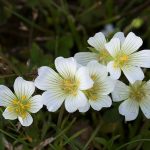 |
These are all distinctive honeys and Sequim Bee Farm makes an excellent product.. Some things like raspberries (grown here) produce little in the way of honey. MINT that used to be grown in Chehalis area made a dynamite honey.
Ended with a commentary on health/allergy benefits. ***
Honey, if properly purchased from a beekeeper that keeps track can also prevent allergies of all sorts.
In the winter you eat last years Spring honey; in the Spring you take the local June – July wildflower and bulk production. In summer you take the last takes, asters/ Goldenrod, August Sept. flowers. Usually beekeepers do not sell much of that as the late product often crystallizes up and does not taste or smell as good.
Tar-weed honey comes to mind. Aster/Goldenrod usually is dark and smells something like sweat socks. Tasted okay, but did not smell good.
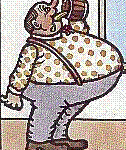 “Might make a good Aster honey mead. “Aster Blaster Mead. – knock your socks off.”
“Might make a good Aster honey mead. “Aster Blaster Mead. – knock your socks off.”
** Asian honey is banned in Europe but our gutted FDA allows it in, worse yet some is smuggled in – up to one-third of all our honey is smuggled in from China and may have pesticides, heavy metals or illegal antibiotics. Europe considers it unsafe. We do not.
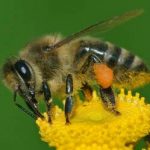
The process of heating and filtering of honey removes all the pollen from that “HEALTH” food. IMO, without pollen, it is simply another sugar intake.
Be it KFC, Smucker, McDonald’s, Walgreens, Rite Aid 100 percent of the honey sampled had no pollen.
“77 percent of the honey sampled from big box stores like Costco, Sam’s Club, Walmart, Target had the pollen filtered out.” Another reason to buy local honey or raise your own. Same with EGGS – my chicken ranch is going chitteringly and at least will be delivering eggs far before I ever get any honey.
HINT! Use shallow or medium supers and only use a full super for the brood chamber and the overwintering box on top.” I actually reduced the size of the original 10 frame Langstroth hive to an 8 frame, meaning it will be at least 10 pounds lighter and easier on this old duffer’s back.
Negative to this being that the narrower profile may make it more tipsy if loaded high. Something this beginning hive manager will have no problem with. The other smaller hive I am experimenting with is the Warre Hive.
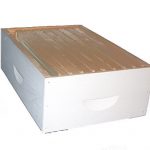 |
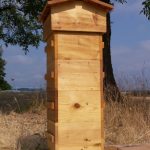 |
Note about swarms in the Pacific Northwest. I am hoping for one more swarm before JUNE and the cool weather is not cooperating.
Italian Queens–
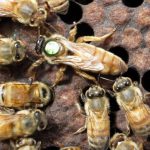 |
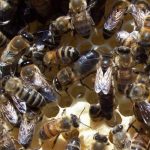 |
| Italian Queens– Their attractive blonde coloration make queen locating less difficult. Superb comb builders. Very gentle, Very Productive but tend to rob other hives. | Carniolan’s are much darker Forages on colder and wetter days than most other bees. Overwinters well on small stores, as queen stops laying in the fall. Explosive build up in early spring. Exceptionally gentle and easy to work. |
The worker bees will only live for about six weeks, but the queen may live for several years, all because of the food they were fed while growing as larva. Swarmed ‘older’ queens may need to be replaced as their productive time has come to a close.
Be it in the choice of hives or breeds I understand I will make mistakes. There are many new things to learn and that is always a joy. As with plants we tend to learn more mistakes…especially from our own.
Here are a few beekeeping mistakes that I have heard of: 🙂
One aspiring beekeeper ordered a queen and then, a few weeks later, called wanting to know why he did not have a hive of bees. He thought that a queen possessed some “magic” power that would pull bees from “out of the air.”
Another man called, requesting a pregnant bee, and another said he had a small ball of bees (about eight hundred) that he wanted to build up. Did we sell “bee eggs”? This was on par with the customer who phoned asking why he could not get a new lawn to grow from grass clippings.
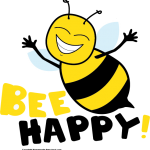
(C) Herb Senft 5/2018
Beekeepers make better lovers because they’re always smoking!
That said, most male beekeepers would be humble in appreciation of a well run society of no-nonsense sisters. They are not very forgiving when it comes to slackers – esp. males.
A few Links:
Miticides and the alternatives:
Tower Hives – an interesting option.
Member of the North Olympic Beekeepers’ Association.
Be sure to visit our NOPBA wonderful archive of monthly Newsletters or visit the library that we loan out to our members

Question was asked “Will the bees tolerate the cedar? I thought Cedar was a bug getter ridder of’er wood.”
Cedar – good question. Remember this is Pacific Red Cedar, not the Eastern Red Cedar which is a Juniper.
The last wild swarm I caught was nesting in a Red Cedar cavity – this choice of habitat is quite common here. Other thing about the cedar is that they do not propolize the wood as much as they do pine. Not sure why.
In Santa Cruz, I used Redwood – seemed to be a similar thing. Pine however is the wood most often used. Ponderosa Pine is great.
Most woods will do, but weight is an issue so using something like Oak would be silly as well as expensive. More important is not to mix different woods (as I just did). since the different species will expand and contract at different rates.
I have had some warping especially with the ones with finger joints. – other issue being routering. Some woods are hard to make clean MitrLok joints with.
Also think that Southern Swamp Cypress would make a great box.
Good beekeeping sayings:
There is no other field of animal husbandry like beekeeping. It has the appeal to the scientist, the nature lover, and even (or especially) the philosopher. It is a chance to work with some of the most fascinating of God’s creatures, to spend time and do work in the great outdoors, to challenge my abilities and continue to learn. My hope is that I never become so frail with old age that I cannot spend my days among the bees. It gives credence to the old saw that “the best things in life are free”. I thank God daily for the opportunity and privilege to be a beekeeper.”
A bit more jaded but also true:
“Beekeepers are the prostitutes of Agriculture. They usually work at night, most wear a veil on their heads. They are called upon when needed, paid, and told to get out when they are done.”
“When you are confronted with some problem in the apiary and you do not know what to do, then do nothing. Matters are seldom made worse by doing nothing and are often made much worse by inept intervention.” –The How-To-Do-It book of Beekeeping, Richard Taylor
Another question: Private:
“Science” or if you prefer, “man”, has known the EXACT chemical composition of honey for many decades.
In addition, they have known the exact percentage of each and every component/ingredient in honey is, for almost as long.
Every component or “ingredient” of honey has been synthesized to an exact chemical duplicate of the natural “ingredient”.
1) Is an artificial honey that is chemically identical to natural honey being produced?
2) If it is, are honey companies mixing the artificial honey with the natural honey?
3) If artificial honey that is identical to natural honey in every way is being manufactured, is it being labeled and sold by honey companies as “100% Natural”?
(Since the “man made” honey is chemically identical to “bee made” honey, no FDA test analyst would be able do detect a difference between them.
It would also be quite possible the FDA knows about and encourages the deception.
Two responses:
Another GREAT question.
I don’t have an answer for you. I suppose they could synthesize it as they could Maple Sugar which also is a bitch to make. My gut feeling that with the availability of cheap corn syrup this is probably done. Who would enforce it is the question. Much like doping of blood, tests, spectrometry and testing for enzymes would be needed to be done. Our present FDA is a tool for the mega corporations and I doubt they would do anything – as does our govt. to regulate smuggled in honey from countries most others ban.
More interestingly this country does not have a standard for “organic honey” so it really cannot be sold as such. Canada and Britain do, but I question some of their standards as it is near impossible to enforce or meet.
Some things just make bloody sense – most probably do not.
The housed hives must be placed on land that is maintained organically. **
The beehives and frames/foundation should be made of natural timber. Treated wood, plastic cannot be used. Common sense things like lead paints of course would be forbidden.
If the EU has standards they would probably be mind blowing impossible to deal with.
** Now since a bee travels up to 2 miles for gather nectar how in the world could they possibly not pick up contaminated chemicals from gardens and or ‘chemical’ using farms.
Enforcing something like that would probably knock down the few we have to those lucky enough to be sited next to DNR or public lands or islands like the New Hebrides and Orkney.
Better explained by a great local honey producer:
“We do not label our honey as organic, intentionally.
According to World-of-Honey.com:
Honey is not included in the USDA’s National Organic Standard; this means there is no legal definition of organic U.S. honey.
Arthur Harvey of the International Association of Organic Inspectors, stated in the Seattle Post-Intelligencer newspaper in 2008 that “what the USDA has said is that you can certify any product as organic as long as you comply with existing regulation, but there are no regulations for honey.
That means the green USDA organic sticker on honey is meaningless.”
Think of it this way. When a farmer grows an organic garden, they can control all sorts of factors; the soil, the seeds, treatments and management. However, this is not the case with bees. Bees have the ability to forage and fly up to 5 miles away from the hive. Our organic farmers’ cabbages never wander that far from home.
The likelihood of the bees coming into contact with non-organic products is rather high, so how in good faith can we (or any other beekeeper and bee product producer) label and market our honey as Organic?
Their website is: https://www.sequimbeefarm.com/organically_grown_honey.php
I strongly recommend their blackberry, fireweed and Natural Meadowfoam Honey
Poetry:
Song of the Queen Bee
Published in the New Yorker in 1945, “Song of the Queen Bee” is told from the queen’s perspective and protests the industrialization of reproduction via artificial insemination.
When the air is wine and the wind is free
and the morning sits on the lovely lea
and sunlight ripples on every tree
Then love-in-air is the thing for me
I’m a bee,
I’m a ravishing, rollicking, young queen bee,
That’s me.
I wish to state that I think it’s great,
Oh, it’s simply rare in the upper air,
It’s the place to pair
With a bee.. . .
There’s a kind of a wild and glad elation
In the natural way of insemination;
Who thinks that love is a handicap
Is a fuddydud and a common sap,
For I am a queen and I am a bee,
I’m devil-may-care and I’m fancy-free,
The test tube doesn’t appeal to me,
Not me,
I’m a bee.
And I’m here to state that I’ll always mate
With whatever drone I encounter.. . .
Mares and cows, by calculating,
Improve themselves with loveless mating,
Let groundlings breed in the modern fashion,
I’ll stick to the air and the grand old passion;
I may be small and I’m just a bee
But I won’t have science improving me,
Not me,
I’m a bee.
On a day that’s fair with a wind that’s free,
Any old drone is a lad for me.
I’ve no flair for love moderne,
It’s far too studied, far too stern,
I’m just a bee–I’m wild, I’m free,
That’s me.
I can’t afford to be too choosy;
In every queen there’s a touch of floozy,
And it’s simply rare
In the upper air
And I wish to state
That I’ll always mate
With whatever drone I encounter.. . .
If any old farmer can keep and hive me,
Then any old drone may catch and wife me;
I’m sorry for creatures who cannot pair
On a gorgeous day in the upper air,
I’m sorry for cows that have to boast
Of affairs they’ve had by parcel post,
I’m sorry for a man with his plots and guile,
His test-tube manner, his test-tube smile;
I’ll multiply and I’ll increase
As I always have–by mere caprice;
For I am a queen and I am a bee,
I’m devil-may-care and I’m fancy free,
Love-in-air is the thing for me,
Oh, it’s simply rare
In the beautiful air,
And I wish to state
That I’ll always mate
With whatever drone I encounter,
All hail the queen!
-E.B. White
The keeping of bees is like the direction of sunbeams. – Henry David Thoreau
Place a beehive on my grave
and let the honey soak through.
When I’m dead and gone,
that’s what I want from you.
The streets of heaven are gold and sunny,
but I’ll stick with my plot and a pot of honey.
Place a beehive on my grave
and let the honey soak through.
-May’s Honey Song, from The Secret Life of Bees, by Sue Monk Kidd (p83)
Plastic foundation and plastic frames.
I tried this approach on a strong swarm and was bitterly disappointed. Mostly by the initial personal reaction to the SMELL of the plastic material delivered in the box. Had to air it out two days before deciding to use it.
Not too much later (heavy bee activity) I checked to see the progress of comb formation. It was ghastly as compared to the normal wax foundation I had used on a much weaker swarm. Wacky would be the word to describe the cross comb laying in the three frames partially filled, some were perpendicular to the frame and two had much more drone cell production. I cut all this out and put in normal foundation. The same hive now is drawing the WAX frames out correctly and evenly, not hop scotch with desert black empty spaces between.
My experience shows the bees will take forever to fill these deep super plastic frames and do so in a poor manner. With the black foundation alone my report is a bit better but not great. If the wax is chewed off you will get this problem. Perhaps in a full and active hive this is not a problem, but it is when you have a beginning hive with a lot of unfilled frames. Medium frame and black plastic foundation might work better but I would never try deep plastic foundation again.
Aside from longevity and less propolis issues the plastic frame is sold as being impervious to wax moths. Not true as they would still go after the finished drawn comb.
Before going this route again I would even put in in foundation-less frames with spaced wax foundation between.
What to use in a Smoker?
One should have cool, non-toxic, and long-burning smoke as the traits most important for the health of the bees and convenience for the beekeeper. “The best (in order of preference) were Sumac seed heads, wood shavings, pine needles, corn cobs, and dried cow pies. Cardboard was toward the bottom of the list (less desirable) along with pine cones, treated card twine, treated burlap. I have been using corn cobs because there is a good free supply at one of my bee-yards, but I am eyeing the sumac seed heads that are now forming on the roadside sumac plantings.”
I would add dried lavender, sage and other fragrant herbs. Dry and put into a small square of cut burlap.
What humans can learn from bees.
https://m.chicagoreader.com/chicago/what-humans-can-learn-from-bees-according-to-chicagos-bicycling-beekeeper/Content?oid=33155287
…when I started Bike a Bee. We place beehives in community gardens on the south side. We place the hives in spring, and then we take care of them throughout the year. We own all the equipment, we harvest all the honey, and we sell it. When I say “we,” it’s the royal we.
HOT TUBS, BEES, and the crystallization of honey.
I had not updated my phone number on craigslist and someone had bees move into their hot tub giving a whole other meaning to a bee congregation. I wrote back suggesting it may resolve itself as such late swarms do not have the food to survive.
Interesting hot tub angle. Honey needs about 140 F (beeswax too) to uncrystallize so putting your honey in the hot tub would not work, unless you crank it up to that setting. This might get a few bum complaints if you did.
That was my contribution to the crystalized honey discussion, as well as plugging clover crystals as being better than letting your blackberry or eucalyptus honey crystalize naturally, which has coarser and less pleasing granulation.
So infect your such honey with clover to crystalize it finer …. or be sure to store it at a temperature not conducive to crystallization.
Anything under 50 and it will crystalize. So keep your honey in a warm cupboard.
WHAT TO DO – fi it does crystallize.
Honey easily returns to a liquid again by heating it. It is best to do it at a low hear and by putting it in a double broiler – put your honey jar in a bowl of warm water and slowly let it warm up. Microwaving works but overheats the honey and does it unevenly and gives poor long-term results. So unless you are in a hurry don’t.
The other answer is simply to enjoy your granulated and well-behaved honey. No more drips on your shirt or pants as you hurry out the door.
Always remember that glass is much preferable over plastic and the only other safe storage is stainless steel or some glazed crockery. Personally, I LOVE crystallized clover honey which is often sold as creamed honey.
Sadly many believe that one WHIPS honey (with a beater) to make creamed honey. Whipping honey is crazy as it introduces oxygen, moisture and possibly foreign microbes into your pure and natural honey.f
Buy locally and sample all the wondewrful variations of this wonderful food.